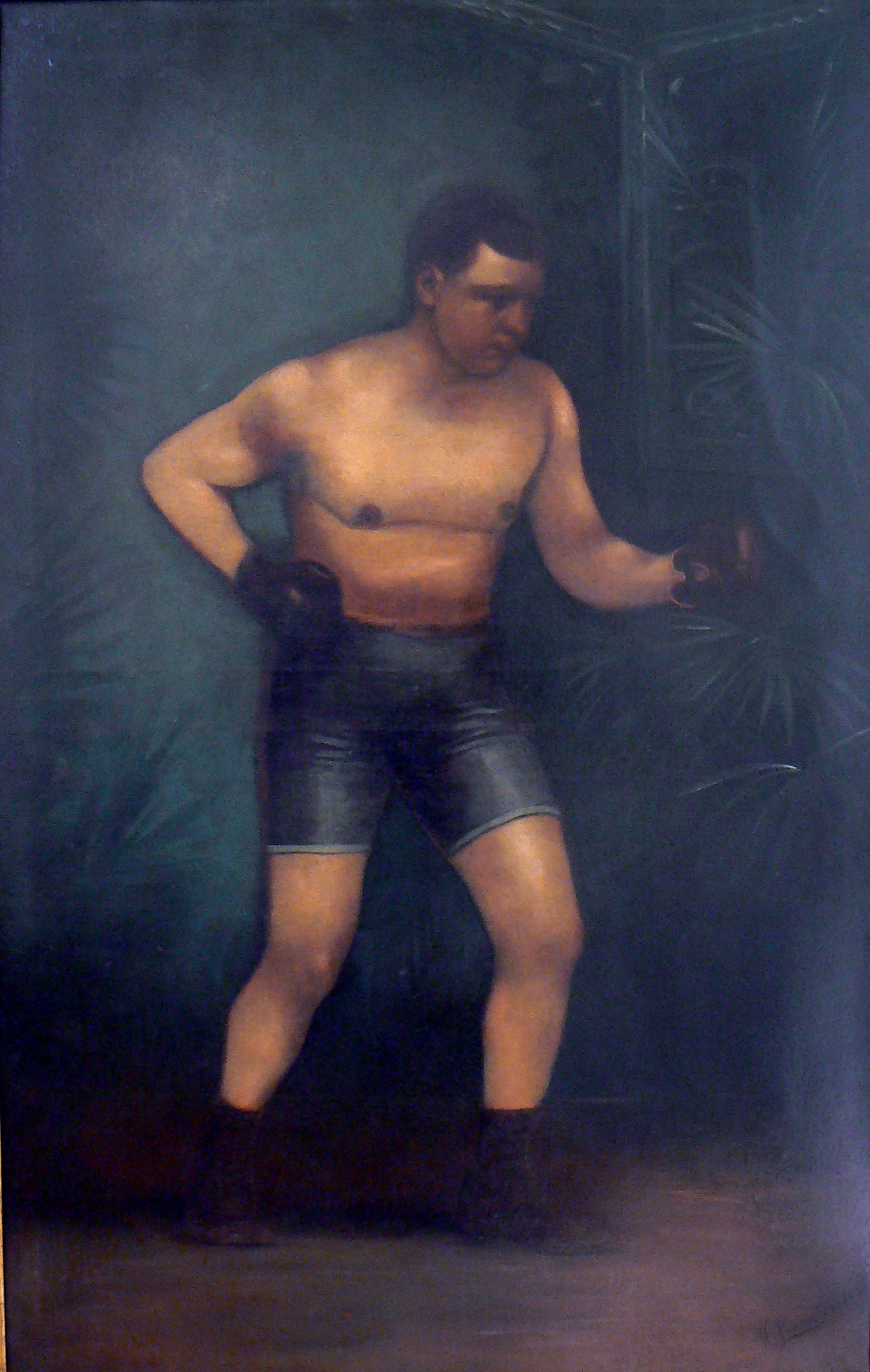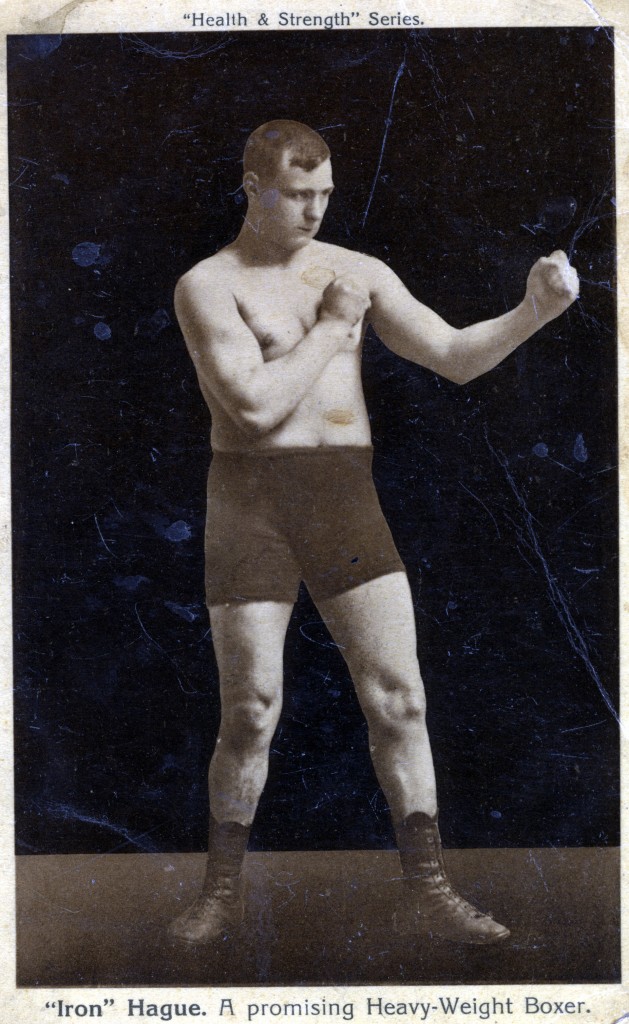James William ‘Iron’ Hague at Cusworth Hall Museum by Neil McGregor

James William 'Iron' Hague by H Lancaster, c.1909/10 © Doncaster Museum Service
Mexborough, a small mining village to the western edge of the Doncaster Metropolitan Borough area, is a one time mining community which has been home to a surprising number of well-known individuals. Perhaps the most famous of those was the Poet Laureate Ted Hughes, who lived there between 1937 and 1948, when his father ran a newsagents shop in the town. Other residents have included British Formula One World Champion racing driver Mike Hawthorn and artist printmaker Edgar Holloway.
The subject of this blog is another resident of Mexborough, who although little known now, was during his brief professional career one of the most highly paid heavyweight boxers that this country had seen. James William ‘Iron’ Hague was born in Mexborough in 1885 and aside from a short period spent working in Scarborough was to spend the whole of his life in the town, dying in 1951.
He acquired his nickname ‘Iron’ during his schooldays. One day, while involved in a playground spat, he was hit over the head with a brick. Undeterred, he wrapped his scarf round his head, held it in place with his school cap, and proceeded to his next lesson. On entering the class he was asked by his teacher to remove the cap. Seeing the size of the wound, and that young Hague had patched it up himself the teacher said “you must be made of Iron lad”; and the name stuck.
After leaving school Hague worked as a miner in Mexborough, boxing first for his local colliery and afterwards in a travelling fair. He also took part in bare-knuckle fights on the local canal bank. Gradually he worked his way up through the amateur ranks, becoming Yorkshire champion in 1905, when he defeated Dick Parkes at Doncaster, and going on to beat a steady stream of English heavyweights, many by KOs.
 It was on the 19th April 1909 that ‘Iron’ Hague met Gunner Jim Moir in the ring of the National Sporting Club to fight for the English Heavyweight boxing title. The fight ended in a knock-out to Hague after just 2mins 47secs. It was reported that around 2,000 people stood outside the Sheffield Telegraph Newspaper Office in Mexborough waiting for news of the fight, and his homecoming saw thousands lining the streets. He defended the title once against Bill Chase, knocking him out in the 6th round, but lost it on 24 April 1911 to the up and coming Bombardier Billy Wells. After losing his heavyweight title Hague resumed his occupation as a miner. On the outbreak of the First World War he enlisted in the army, serving in France, and seeing action on the Somme and at Passchendaele. After the war he returned to Mexborough, where, crippled by a combination of mustard gas and barbed wire, he worked as a barman in local pubs.
It was on the 19th April 1909 that ‘Iron’ Hague met Gunner Jim Moir in the ring of the National Sporting Club to fight for the English Heavyweight boxing title. The fight ended in a knock-out to Hague after just 2mins 47secs. It was reported that around 2,000 people stood outside the Sheffield Telegraph Newspaper Office in Mexborough waiting for news of the fight, and his homecoming saw thousands lining the streets. He defended the title once against Bill Chase, knocking him out in the 6th round, but lost it on 24 April 1911 to the up and coming Bombardier Billy Wells. After losing his heavyweight title Hague resumed his occupation as a miner. On the outbreak of the First World War he enlisted in the army, serving in France, and seeing action on the Somme and at Passchendaele. After the war he returned to Mexborough, where, crippled by a combination of mustard gas and barbed wire, he worked as a barman in local pubs.
The picture itself has had an interesting history. It was originally commissioned to hang at the National Sporting Club in London. After being displayed there for many years it was returned to Hague’s daughter, who loaned it to the Mexborough Miner’s Welfare Club. For a while the painting was also loaned to the Boxing Hall of Fame in London. When that institution closed the picture went missing, and was finally tracked down to a storage unit in Croydon, from where it was returned to Hague’s granddaughter, who lives in Mexborough.
The painting is by H. Lancaster (unknown dates), and was probably painted to commemorate Hague’s victory over Gunner Jim Moir in April 1909. H. Lancaster appears to have worked in Swinton – whether Swinton, South Yorkshire or Swinton, Manchester is not yet known. There is one other known painting by the artist in public collections; a portrait in the collection of Salford Art Gallery of William Paddison Kidd (1866-1941), who was chairman of the Swinton & Pendlebury Urban District Council between 1911 and 1913.
The painting was offered to Doncaster Museum Service last year, by Hague’s granddaughter who felt strongly that it should be in a public collection, and that it should remain in Doncaster. Like many regional museums Doncaster Museum Service no longer has a purchase fund, and so the usual round of grant applications were put together, and the service was lucky enough to receive half the cost of the picture from the V&A Purchase Grant Fund. The remainder of the money was raised by public donations after a highly successful fund-raising campaign, and Doncaster Museum Service is indebted to those members of the public who contributed so generously, insuring that the picture remained in Doncaster. The painting is now hanging on permanent display at Cusworth Hall Museum, in a room devoted to sport in Doncaster.


